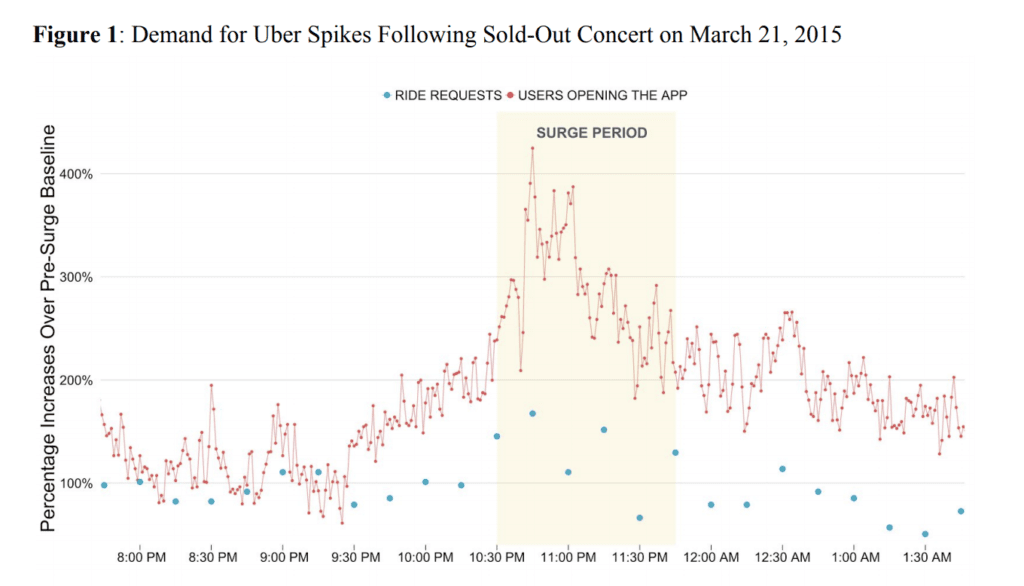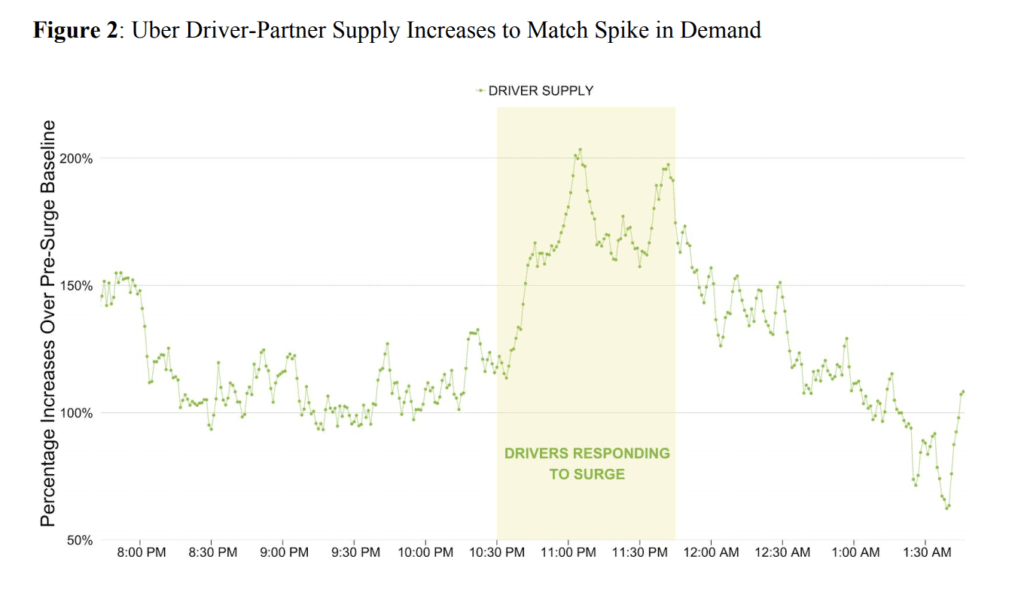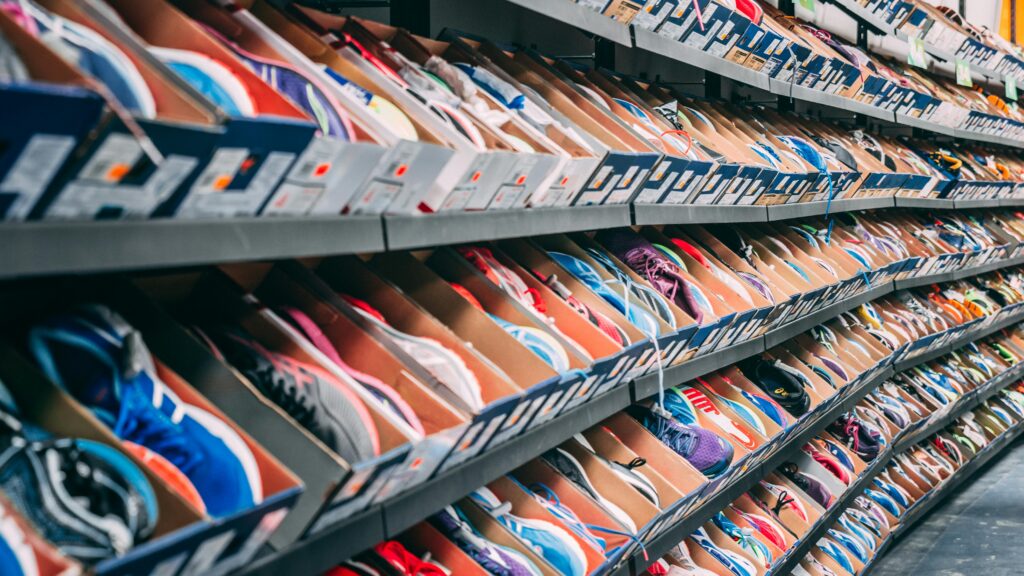In today’s cutting-edge, digital marketplace where disruption is only a popular app away, there are many ways to implement pricing strategies that appeal to customers’ willingness to pay while maximizing a company’s profitability. However, not many companies have initiated a strategy with such interesting results for both the customer’s experience and the company’s bottom-line as Uber did with their introduction of surge pricing.
What is Surge Pricing?
An equilibrium price is one that matches the variables of consumer demand with the product or service’s availability. When these two factors stay somewhat consistent over a long period of time, a pricing strategy based on “fixed-pricing” emerges, where the price remains at the same or similar point over an extended period of time. However, when the selling environment is in flux and the marketplace demand is inelastic, companies will implement surge pricing in order to capitalize on consumers’ willingness to pay, and in Uber’s case, draw more drivers to a locale where they are needed to meet the demand. Though this might be a new method in the ride-hailing space, airlines and other industries have been implementing this pricing strategy for a long time—possibly without you even being aware of it.
Though Uber’s upfront pricing is a unique draw for customers looking for a ride around the city—as opposed to the infamously quick-rising taxi dashboard—you may be familiar with the uncomfortable shock of a dramatically more expensive ride home during a night like New Year’s Eve. The algorithmic technique that Uber uses to decide on a final price for the customer involves many factors, including the immediate conditions of time, place and setting of the requested drive.
How Uber Uses Surge Pricing on New Years Eve
Despite the fact that New Year’s Eve will look quite different this year—busy streets full of honking cars and rowdy midnight crowds will merely be a fond memory—we can still gain insight into Uber’s unique pricing strategy by looking at an example of surge pricing on New Year’s Eve. On this buzzing night, crowds celebrate (or bid good riddance) to the year with a long night on the town enjoying food, drink and any excess energy they had bottled up. With the masses planning a night out far in advance, transportation services jump into action at the opportunity to get their hands on the freely flowing cash and potentially lowered discretion on this long-awaited night out. And yet, according to Uber’s justification, since there is higher demand and only so many drivers out patrolling the streets, the company can charge a premium for their highly sought-after services. When a scarcity of drivers is paired with an excess of demand, it is an optimal time for Uber to answer the question on the partygoers’ mind: “How will I get home with the least amount of effort and the most amount of comfort?” Even though it’s at a higher cost, the special circumstances of the evening allows Uber to use strategic surge pricing to impressive effect.
When people need a comfortable, late-night ride home that they’ve been planning for a while, chances are high that they are ready to spend a little extra and satisfy the multiplier of Uber’s pricing algorithm. It is more of a necessity than a luxury, as opposed to an average weekday at 5:30 pm when the winter weather may be a bit bothersome for pedestrians.
What are the Benefits of Surge Pricing?
In Uber’s own words, their reasoning for surge pricing is summed up below:
“Surge pricing is a relief valve for the ridesharing marketplace. Without it, when demand for rides exceeds the number of available drivers, riders would wait longer (or might not be able to get a ride at all). Drivers would have less incentive to accept requests in busy areas. Surge pricing helps restore balance to the network.
It is interesting to analyze the actual benefits of this strategy, which a few business journals have done. Economics for Life carried out a study on the strategy’s effectiveness by studying the landscape of a post-Ariana Grande concert surge in New York City. By tracking the app-opens and ride requests in the specific area of Madison Square Garden, they gained insight into the way surge pricing intersected with customer demand.
Source: http://economicsforlife.ca/wp-content/uploads/2015/10/effects_of_ubers_surge_pricing.pdf
“The first beneficial effect of surge pricing was to increase the number of driver-partners in the area. Surge signalled that this was a valuable time to be on the road, and driver partner supply increased by up to 2x the presurge baseline. This increase in driver-partner supply was a net win for riders in the area because more of them were able to take advantage of Uber services.”
Source: http://economicsforlife.ca/wp-content/uploads/2015/10/effects_of_ubers_surge_pricing.pdf
The research goes on to indicate that “the second effect of surge pricing was to allocate rides to those that value them most. While the number of app-openings increased dramatically, the number of actual requests didn’t increase by as much. This came from riders who opened the app, saw that surge pricing was in effect and decided to take an alternate form of transportation or chose to wait for surge pricing to end. From an economic efficiency standpoint, this was highly beneficial because those that ended up requesting a ride are those for which their outside option was worse, leading them to value Uber more in that particular moment.” By monetizing the specific customer’s higher valuation, while eliminating the low-value business, Uber’s surge pricing effectively filters and offers the service to those who are willing and ready to pay a premium.
Implementing a Surge Pricing Strategy
Though New Year’s Eve will look dramatically different this year, it is important to identify gaps or opportunities in your own industry where techniques similar to surge pricing can be applied. For many, this year’s locked down New Year’s Eve will look like staying home, ordering in food and maybe even buying a few extra bottles to maintain the celebratory supply. Companies in the food delivery, meal kit, and liquor sales space could apply similar surge pricing techniques to keep up with the increased demand to make the night special for willing customers, even when they won’t be hailing a ride to get to the big party.
RML Can Help With Your Surge Pricing Strategy!
If there’s one thing we can learn from Uber’s use of surge pricing, it’s that you must ensure your company is consistently analyzing and optimizing your pricing strategy to meet customer demand while also strengthening your bottom-line. Trends change over time; the marketplace is based on ever-shifting variables; your customer will shift in their wants, needs and willingness to pay. As Uber did with their unique pricing strategy, it is imperative to stay abreast of all the changes, especially in a post-COVID-19 world, so that your organization can ensure it is maximizing revenue and offering the best possible product or service to your customer.
Source of Uber Surge Pricing study: economicsforlife.ca
ABOUT THE AUTHOR Conor Sweetman is a Marketing Associate at Revenue Management Labs. Revenue Management Labs help companies develop and execute practical solutions to maximize long-term revenue and profitability. Connect with Conor at csweetman@revenueml.com






